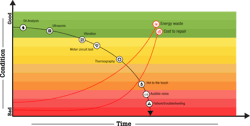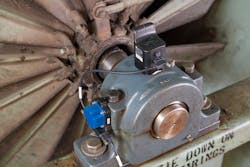Understanding P-F Curve Modalities and Inherent Availability: Part 2
This is Part 2; Read Part 1: P-F Curve Intersections With Maintenance & Reliability Approaches.
The P-F Curve is a graph that shows where an asset is in its lifespan based on its condition. Progressing along the P-F Curve indicates deterioration, with the “P” referring to “potential failure,” which is when an identifiable physical condition indicates that functional failure is imminent, and the “F” referring to functional failure, which is when an asset is still operational, but no longer performing as intended.
The P-F interval is the time between the first point of potential failure and functional failure. An asset does not become completely non-functional until it reaches catastrophic failure.
An asset’s condition can be measured and monitored using any of a number of modalities. The right modality for each asset is based on a range of factors, including the operational context of the asset, its criticality, identified failure modes, and the maintenance budget available. The earlier failure is detected, the more wear and damage can be prevented, and the life of the asset can be extended. But not every asset needs the earliest possible detection of failure.
The methods that can detect failure the soonest can require sophisticated tools or analysis that make them impractical for some assets or scenarios.
Five ultra-sensory modalities commonly used to identify an asset’s inherent availability point on the P-F Curve are, roughly in order of how early they can detect indications of potential failure, oil analysis, ultrasound, vibration monitoring, thermography, and motor testing.
Oil Analysis
Oil analysis is best for finding faults in oil-cooled components. It can detect signs of failure extremely early on, including the presence of lubrication breakdown, overheating, and component wear. It's most commonly used on gearboxes, compressors, and other moving or rotating parts. Oil analysis is an advanced method of detecting failures. Diagnosing failures detected using oil analysis may require an outside lab.
Ultrasound
Compressed air is an expensive resource, and it’s the largest source of energy waste in manufacturing. Ultrasound can detect sounds that human ears can’t, especially in noisy environments, making it possible to identify leaks so they can be fixed at the source. In addition to compressed air, other common types of leaks include refrigerant, gas, and ammonia.
Using ultrasonic leak detection, teams can find and fix problems with valves, steam traps, bearing lubrication or potential electrical safety hazards.
Vibration Monitoring
Vibration monitoring is most effectively used to identify mechanical faults on rotating equipment. It is one of the most common and accessible ways to track an asset’s condition. Vibration monitoring can pick up indicators of the four most common mechanical methods of failure: imbalance, misalignment, looseness, and bearing wear. It can also detect faults with rotating elements, resonances, structure, etc. When an issue is detected, vibration analysis can identify the specific fault and its severity.
Thermography
Thermography is best for finding process issues, electrical hot spots, and severe mechanical faults, such as misalignment, gearbox or belt problems. It's often recommended for time or fault-based inspection routes, because some damage may have already occurred by the time an asset experiences overheating.
Motor Testing
Motor testing, also known as motor circuit analysis, is electrical condition monitoring intended to prolong the life of motors. Different types of tests can be performed on motors depending on whether they are in operation or not—in other words, while they are energized or de-energized. The different types of tests can uncover the same failure modes using different methods.
Inherent Reliability vs Inherent Availability
Inherent reliability measures how robust an asset or system is and represents its upper limit of reliability (left of the PF curve) that can be attained through design, installation, and proactive maintenance techniques. The P-F Curve helps teams identify where an asset is in its lifespan so that its lifespan can be maximized, and its inherent reliability can be fully realized.
Inherent availability represents the upper limit of maintainability when it considers only the corrective nature to restore an asset back to its upper limit of reliability. In other words, no amount of maintenance within the Inherent Availability realm (on the PF curve) will ever raise the Inherent Reliability factor, otherwise known as its resistance to failure.
Combining tools and techniques found in Reliability Centered Maintenance (RCM) and/or Defect Elimination approaches can help organizations continuously improve their maintenance strategies per asset according to fit, form, function, and failure to get the most out of their assets. Or otherwise called the asset’s maximized Inherent Availability. That is the name of the game.
Read Part 1: P-F Curve Intersections with Maintenance & Reliability Approaches here.
Gregory Perry is a Senior Capacity Assurance Consultant with eMaint, part of the Fluke Reliability family. He's a Certified Reliability Leader (CRL) and Certified Maintenance Reliability Professional (CMRP) with nearly two decades of experience in maintenance and operational best practices. Perry is dedicated to positive client relationships while bringing to the table a broad base of experience in the areas of MRO and storerooms, world-class maintenance principles, CMMS consultation, and leadership.
As a mechanical application and product specialist with Fluke Reliability, John Bernet works with customers from all industries to successfully implement their reliability programs. He has more than 30 years of experience in the maintenance and operation of commercial machinery and as a nuclear power plant electrician in the U.S. Navy. He holds a Category II Vibration Analyst certification and is a Certified Maintenance Reliability Professional (CMRP).
About the Author
Gregory Perry
eCMP, CMRP, CRL—Senior Consultant, Fluke Reliability
Gregory Perry has two decades of experience in maintenance and operational best practices and is dedicated to positive client relationships. He brings a broad base of knowledge to customers, including MRO, world-class maintenance principles, with world-class CMMS consultation and leadership. In addition to providing CMMS implementation and consultative services, Perry also presents maintenance best practices sessions at leading industry conferences and has authored several online best practices webinars.
John Bernet
Certified Maintenance Reliability Professional – Fluke Reliability/Fluke Corp.
As a mechanical application and product specialist with Fluke Reliability, John Bernet works with customers from all industries to successfully implement their reliability programs. He has more than 30 years of experience in the maintenance and operation of commercial machinery and as a nuclear power plant electrician in the U.S. Navy. He holds a Category II Vibration Analyst certification and is a Certified Maintenance Reliability Professional (CMRP).


